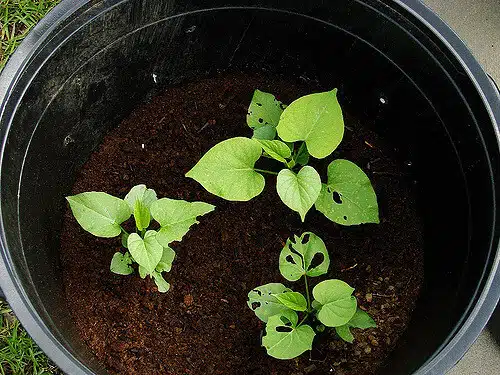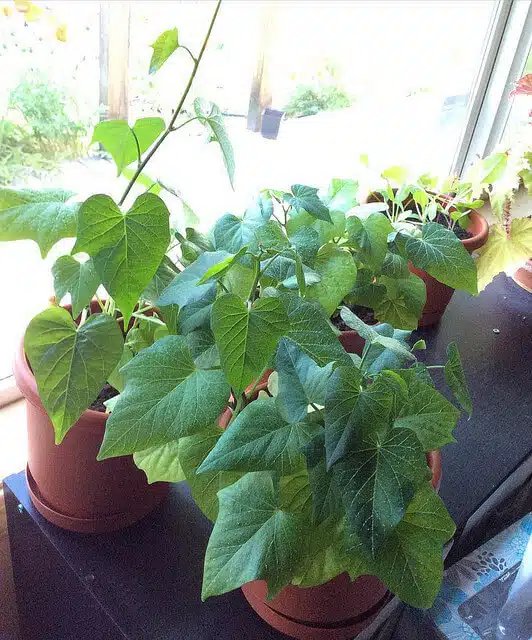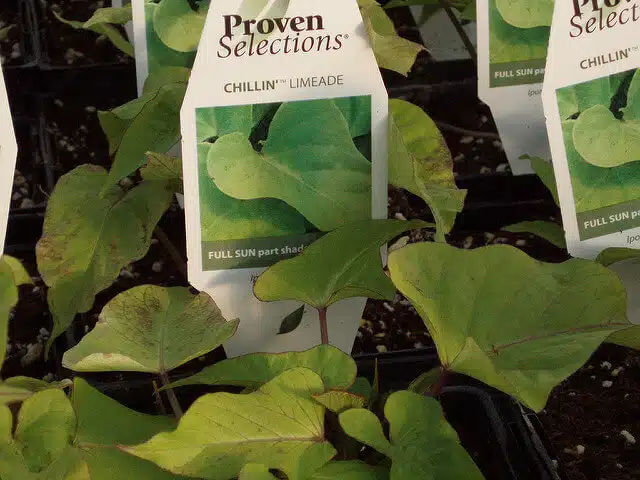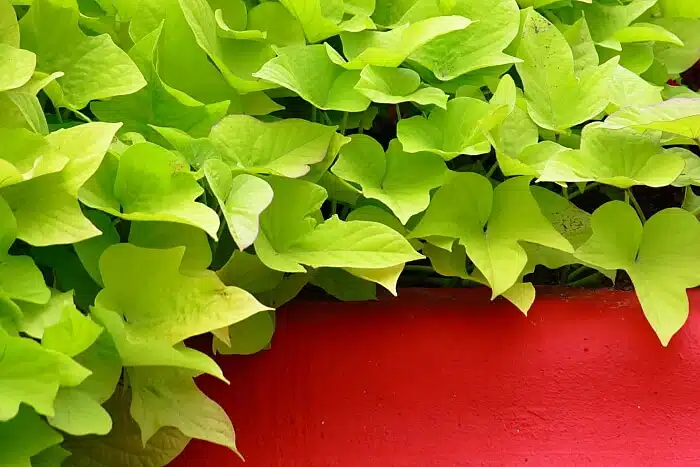When it comes to growing sweet potatoes in pots, there isn’t a great deal of information available for container gardeners. I imagine it’s because they’re a relatively “new” vegetable. Their popularity is a recent phenomenon.
My trusty copy of D.G. Hessayon’s The New Vegetable and Herb Expert (an old-school classic gardening book written in the nineties) only contains a thirteen line snippet about the pink-coloured tubers. He writes that, “Many people find the boiled tubers too sweet with meat and fish….” Clearly he’s not writing for a modern audience!
Though they aren’t the easiest crop to grow, they’re certainly not difficult. As a vine (unlike traditional potatoes), they don’t take up a lot of vertical space, so will fit nicely in among your other plants. Equally, they don’t require much maintenance. You can plant the slips (shoot cuttings that are ordered through the mail instead of seed potatoes) and leave them to it (more or less).
They need a long growing season and really dislike cold weather (another reason why many are dissuaded from growing them) but, as long as you plant at the right time and bring them indoors if you’re expecting a frost, there shouldn’t be any issues. This guide will cover everything you need to know about sowing, growing and harvesting. Let’s dig in.
Factsheet
| Slip sprouting time: | Two weeks |
| Time from sowing to harvest: | 5 – 6 months |
| Size of pot: | Large |
| Difficulty of growing in pots? | Medium |
Sowing and harvesting calendar
Sow: Mid March to April
Harvest: Late October to December
Potting soil tips
- Avoid heavy potting soil with lots or large pieces of debris (rock, wood ec.), which can stunt the roots. Use 50% potting compost and 50% horticultural sand. If you want to make your own mix, 1/4 coir, 1/4 homemade/pure compost and 1/2 sand is a good recipe (there’s no need to go to the trouble though if it’s easier to get a ready-made potting mix).
- Add a few handfuls of slow-release fertilizer to your potting mix if you don’t intend to liquid feed through the growing season. Make sure it’s a balanced fertilizer. Too much nitrogen will result in lots of lush foliage but underdeveloped tubers.

- Use as big a pot as you can. Potato grow bags are always a good option.
- One good tip is to use a black pot and/or wrap it in bubblewrap. This will help keep as much heat in as possible.
Sowing and planting
- Whilst it is possible to grow sweet potatoes from seed potatoes, results can be a bit hit and miss. Your best bet is to buy slips from a seed company. These are young vine shoots. Alternatively, you can buy rooted plugs if you can find them.
- Pop your slips into small pots as early in the year as possible (February or March), water them well, and leave them on a warm, sunny windowsill to root.
- If they look half-dead when they arrive in the post, don’t worry! Put them into a jar of water and leave them overnight. Pot them in the morning.
- If you have ordered plugs (young plants), keep them inside until the weather warms up. You may want to pot them on if they’re bursting out of the plugs.
- In either case (slips or plugs) harden them off for a week before planting. Leave them outside during the day when weather is good and bring them in overnight.
- Plant up to five individual plants per pot (assuming it’s a reasonably large pot).
- Newly-planted sweet potatoes will benefit from a little cloche or fleece protection.
Growing tips
- Sweet potatoes are an excellent choice for south-facing, sunny windowsills or conservatories. They’ll be grateful for the heat. They’ll also look fantastic nestled in among your chillies, tomatoes and peppers. If you don’t have that kind of space available, however, they are still perfectly suitable for growing outdoors.
- The plants are re relatively trouble free but there are three main things to keep in mind: watering, feeding and protection from the cold.
- Water them regularly through dryer months but don’t overdo it. They don’t like sitting in damp soil.
- Feed twice a month with a balanced liquid fertilizer. You can also use a seaweed fertilizer (once a month) if you like.

- Throughout late spring and summer, frost won’t be too much of an issue. If you do have a cold spell outside of these times (early spring/late summer), the results can be fatal. Keep an eye on the weather forecast and either bring your pots indoors or provide fleece/a cloche if you have one.
- If you’re unlucky enough to have a frost before the potatoes are ready to harvest and the leaves die, don’t panic. Leave them be and the tubers will draw the remaining energy from the foliage and continue to develop.
- Providing a trellis (such as a bamboo cane wigwam) will give the vines something to wrap round and stop them from trailing over the floor.
- It would be remiss not to mention their flowers. In summer you’ll have a wonderful burst of cone-shaped white-purple or purple flowers.
- One good tip is to grow your own slips. Take some cuttings (of youngish growth) and then root them in water before potting. Overwinter them in a warm place, ready to pot on next year.
Harvesting
- The best way to check if sweet potatoes are ready for harvesting is to nudge back a little soil and see if you can find a developed tuber. Remember, they need a long growing season, so make sure they’ve had adequate time.
- Generally speaking, when leaves start to turn yellow and die back, then you can begin harvesting.
- Leave tubers in a warm, dry place for a week so that the skins can harden up.
- Tubers only start to form when the days and nights are of equal length.
- Don’t leave tubers in pots over winter. Once they’re ready to harvest, get the lot out. They can rot if left in damp, cold conditions.
- Don’t forget that the leaves are edible! Young tender shoots are particularly nice. Pick them sparingly throughout the growing season. Snip off fresh growth for cooking before harvesting,
Pests and problems
- Because of the lovely edible leaves, slugs can be a problem. Copper wire around the pot is a good remedy. Of course, you can never beat a nightly patrol around your container garden.
Good sweet potato varieties for pots
Because sweet potatoes are relatively new, seed companies haven’t yet developed a truly cold-hardy variety. Similarly, yields tend not to be prolific. This may soon change as cultivators seek to breed new varieties so keep an eye on seed catalogues. There are still some good options, however, for container growers.

Good varieties for US growers include:
- Beauregard – Probably the most popular sweet potato variety for home growing, Beauregard is well-suited to containers. The tubers are the typical orange colour that people expect and it’s a particularly high-yielding variety.
- Centennial – This variety is good for Northern Hemisphere container growers for two reasons. First off, it’s a relatively small variety that produces lots of smaller-sized potatoes. Second, it’s been bred specifically as a short-season crop. It will be ready to harvest in less than four months.
Good varieties for UK growers include:
- Beauregard – Like in the US, this is one of the most ubiquitous varieties. A good choice.
- O’Henry – A compact, high-yielding white-fleshed variety that is known for its sweetness. The ability of the tubers to be successfully used as seed potatoes has been cited in the past, so go with these if you want to use some to start new plants next year.
In the kitchen
Because of their high sugar content, sweet potatoes are probably one of the most versatile veggies you can get your hands on. You can do far more with them than normal potatoes. The leaves are also apparently popular in African and West Indian cuisine. An excellent opportunity to try new recipes if ever I’ve heard one! Here are a few of my favourite recipes from around the web:
- Sweet Potato Brownies (Deliciously Ella) – This is a classic of Deliciously Ella’s and well worth a try.
- Stir Fried Sweet Potato Leaf (RasaMalaysia) – I visited Malaysia but don’t think I ever tried sweet potato leaves. It won’t be a mistake I make again!
More Resources
- Grow Your Own Crops in Pots by Kay Maguire – An excellent book that should be on every container grower’s bookshelf.
- Sweet Potatoes: Roasted, Loaded, Fried, and Made into Pie by Mary-Frances Heck – A superb collection of sweet potato recipes.
What are your thoughts? Leave a comment below!
Have you tried growing sweet potatoes in containers? Leave a comment below and let me know how it went!
Image credits: M.Christian; J D; Sara Thompson; Annette Taratuta.

Hello, Dan! Thank you for walking me through the process of planting my plant. Your post helped me grow healthy and sweet potatoes – they’re so wonderful! Looking forward reading more of your post!
Thanks so much Ella!